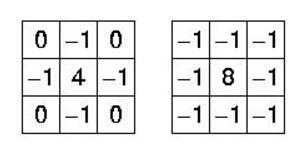对于图像求一阶导数和二阶导数可以增强图片或者求图像的边缘。
一阶导数:
我们知道在数学中一阶导数的求法为:
在图形学中由于图片是按像素来离散组成的,所以最小的h取值为1,所以计算后:
所以图像的一阶导数就是图像亮度的变化率,对于一个灰度图像,他的一阶导数计算如下:
灰度图像矩阵:
a b c
d e f
g h i
那么对于中心像素e:
dx=f-e(或者f-d)
dy=h-e(或者h-i)
当然如果用sobel算子的话
dx=(c+2f+i)-(a+2d+g)
dy=(g+2h+i)-(a+2b+c)
所以在图像边缘检测中,sobel算子的卷积因子为:

可以看出这个卷积因子其实就是sobel算子求图像一阶导数。
二阶导数:
所以当h=1时:
这时可以化简:
这一步在数学中推导为(数学差的我看了一上午才看懂):

令x=x-1
则:
在x和y方向上,有:
把x方向和y方向的二阶导数结合在一起:
这实质上就是著名的拉普拉斯二阶微分算子(Laplacian),拉普拉斯二阶导数还有其它的形式,例如:
所以 Laplacian算子的卷积因子有以下两种:
